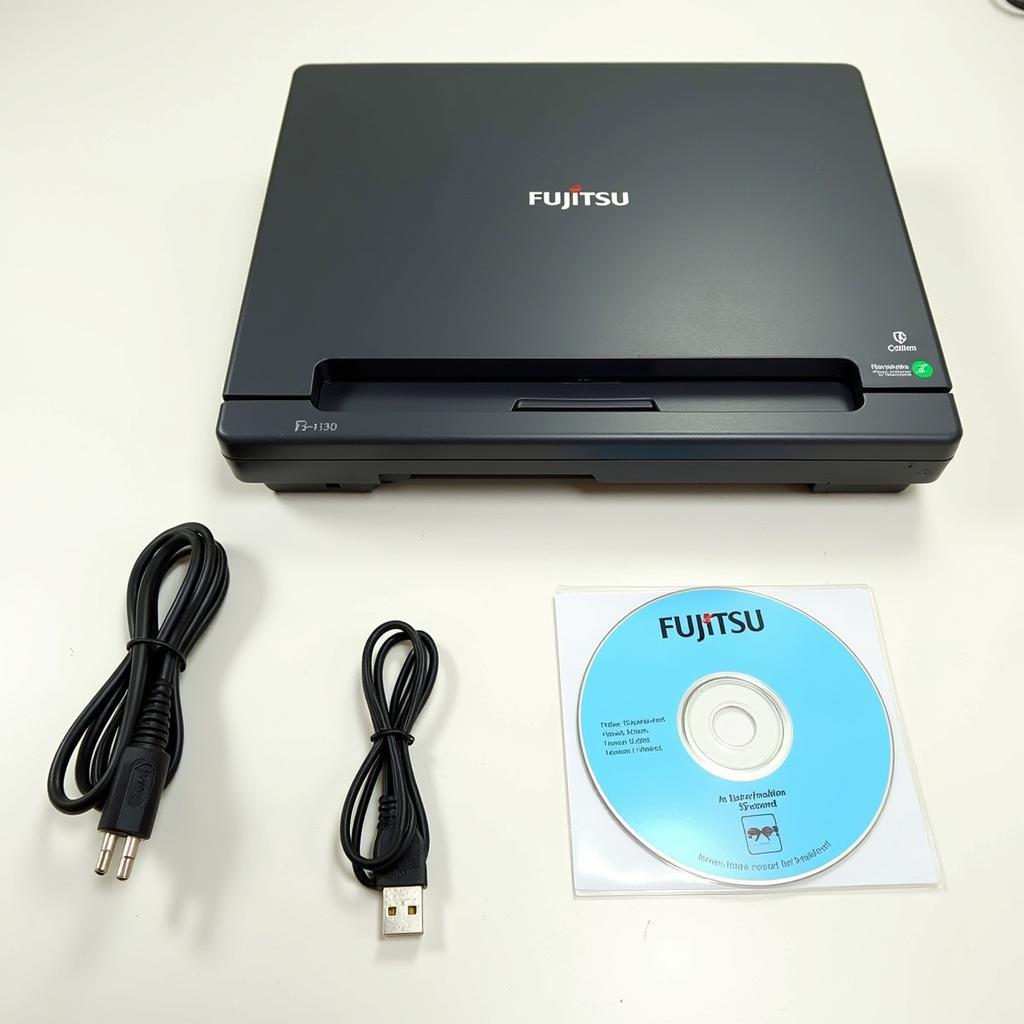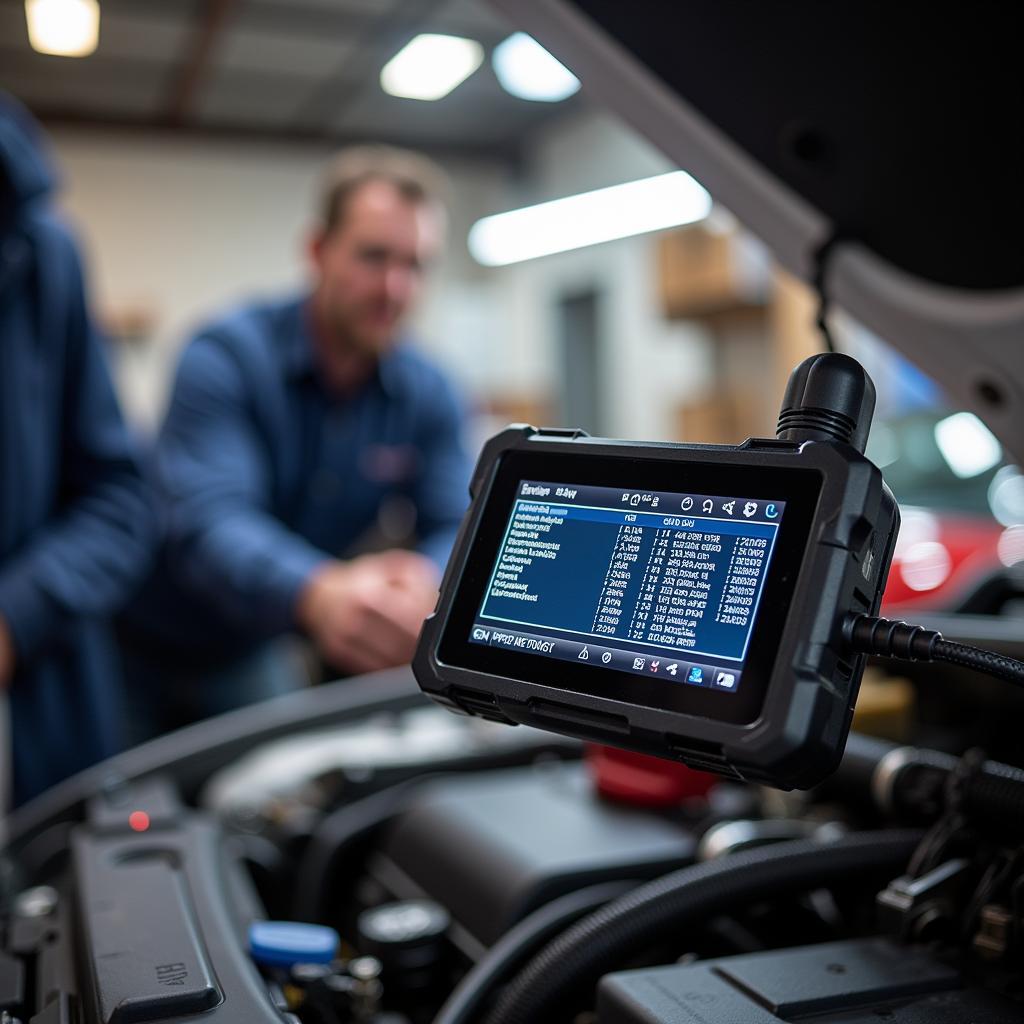In today’s digital age, cars are more technologically advanced than ever. With this advancement comes complexity. When your car throws a dashboard warning light, it can be a guessing game to figure out the problem. That’s where the Best Car Fault Code Scanner comes in. This guide will equip you with the knowledge to understand, choose, and use a car fault code scanner effectively.
Why You Need a Car Fault Code Scanner
A car fault code scanner, also known as an OBD2 scanner, is a device that reads diagnostic trouble codes (DTCs) stored in your car’s computer. These codes are triggered when the onboard computer detects an issue within the engine, transmission, emissions system, or other critical areas.
[image-1|best-car-fault-code-scanner|Car fault code scanner plugged into a car’s OBD2 port|A close-up image of a sleek and modern car fault code scanner being plugged into the OBD2 port located under the dashboard of a vehicle. The image highlights the connection point and the scanner’s display screen, which shows a diagnostic trouble code being retrieved.]
Having a car fault code scanner provides numerous benefits:
- Save Time and Money: Quickly identify car problems yourself, potentially saving expensive trips to the mechanic for a diagnosis.
- Empower Yourself: Take control of your car maintenance and repairs by understanding the issue before seeking professional help.
- Prevent Further Damage: Early detection of car problems using a code scanner can prevent minor issues from escalating into major and costly repairs.
- Improve Resale Value: A well-maintained car with a documented service history, including scan reports, can command a higher resale value.
Types of Car Fault Code Scanners
Car fault code scanners are available in a range of complexities and price points:
1. Basic Code Readers
- Functionality: These entry-level scanners read and clear basic engine-related DTCs. They are an affordable starting point for car owners.
- Suitable for: Car owners who want a basic understanding of their car’s engine health.
2. Advanced Code Readers
- Functionality: Offer more features than basic code readers, including the ability to view live data streams from the car’s sensors, graph data, and access manufacturer-specific codes.
- Suitable for: DIY enthusiasts and car owners who want more in-depth diagnostic capabilities.
[image-2|advanced-obd2-scanner|Mechanic using an advanced OBD2 scanner|A mechanic in a professional workshop is shown using an advanced OBD2 scanner on a car raised on a lift. The scanner’s display is visible, showcasing live data streams and graphs related to the vehicle’s engine performance.]
3. Professional-Grade Scanners
- Functionality: The most comprehensive type of scanner, offering the widest range of features, including bi-directional control (performing tests), coding and programming capabilities, and access to all vehicle modules.
- Suitable for: Professional mechanics and experienced DIYers who need advanced diagnostics and programming capabilities.
Choosing the Right Car Fault Code Scanner
Consider these factors when choosing a car fault code scanner:
- Your Budget: Set a budget before you start shopping, as prices can vary significantly.
- Your Car’s Make and Model: Some scanners are designed for specific makes and models, while others are universal.
- Features: Determine which features are essential for your needs, such as live data, graphing, and bi-directional control.
- User Friendliness: Choose a scanner with a clear display, intuitive interface, and easy-to-understand instructions.
- Updates: Opt for a scanner that offers regular software updates to stay compatible with the latest car models and technologies.
How to Use a Car Fault Code Scanner
Using a car fault code scanner is generally straightforward:
- Locate Your Car’s OBD2 Port: This port is typically located under the dashboard on the driver’s side.
- Plug in the Scanner: Turn the ignition to the “on” position but do not start the engine.
- Read the Codes: Follow the on-screen prompts to read the stored DTCs.
- Interpret the Codes: Look up the meaning of the codes in the scanner’s manual or online.
- Clear the Codes: After addressing the underlying issue, use the scanner to clear the codes from the car’s computer.
[image-3|mechanic-using-code-scanner|Mechanic using a code scanner to diagnose a car problem| A mechanic is shown using a code scanner to diagnose a car problem. The scanner is plugged into the OBD2 port, and the mechanic is looking at the screen, which displays a diagnostic trouble code. ]
Common Car Fault Codes and Their Meanings
Here are a few common car fault codes and their general meanings. Keep in mind that specific code definitions can vary by make and model:
- P0442: Scan tool code P0442 indicates a minor leak in the evaporative emissions control system.
- P0420: Indicates a potential problem with the catalytic converter.
- P0300: Indicates a random misfire in one or more cylinders.
Remember: These are just a few examples, and it’s crucial to look up the specific meaning of any codes your scanner retrieves for your car’s make and model.
Car Code Scanner SRS and Other Systems
Modern cars have various electronic control units (ECUs) that manage different systems, including the Supplemental Restraint System (SRS), also known as the airbag system. Car code scanner SRS tools are specifically designed to diagnose and sometimes reset airbag-related fault codes.
Beyond SRS, some scanners also offer diagnostics for other systems like ABS (Anti-lock Braking System), TPMS (Tire Pressure Monitoring System), and transmission systems. If you’re looking for diagnostics beyond the engine, consider a scanner with these capabilities.
Scanner to Program Car Keys and More
Advanced car fault code scanners can do more than just read and clear codes. Some models can also be used as a scanner to program car keys, offering a cost-effective alternative to dealership programming.
Additionally, you can find ETC scan tool options, specifically designed for diagnosing issues within electronic throttle control systems.
“The ability to program keys and access specialized systems like ETC using a car code scanner can be incredibly valuable for both car owners and mechanics,” says John Smith, Senior Automotive Engineer at XYZ Automotive. “It reduces the reliance on dealerships and specialized equipment, saving both time and money.”
CAT Scans and Other Diagnostic Tools
While car fault code scanners are incredibly useful, it’s important to note that they are just one tool in a mechanic’s arsenal. For more complex issues, professional-grade diagnostic equipment like CAT scans and other diagnostic tools might be required.
These tools provide a deeper level of analysis and are often used to diagnose problems with internal engine components, complex electrical systems, and other areas beyond the scope of a standard code scanner.
Conclusion
Investing in the best car fault code scanner for your needs is a wise decision for any car owner or mechanic. These tools empower you with the knowledge to understand your car’s health, diagnose problems early on, and potentially save money on costly repairs.
By understanding the different types of scanners, their features, and how to use them effectively, you can take control of your car maintenance and keep your vehicle running smoothly for years to come.
Need help choosing the best car fault code scanner for your needs? Contact ScanToolUS today at +1 (641) 206-8880 or visit our office at 1615 S Laramie Ave, Cicero, IL 60804, USA. Our team of experts is ready to assist you!



Pingback: Can I Start My Car While the OBD2 Scanner Is Plugged In? - Car Scan Tool